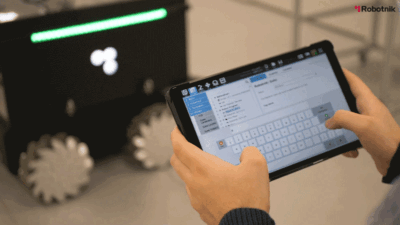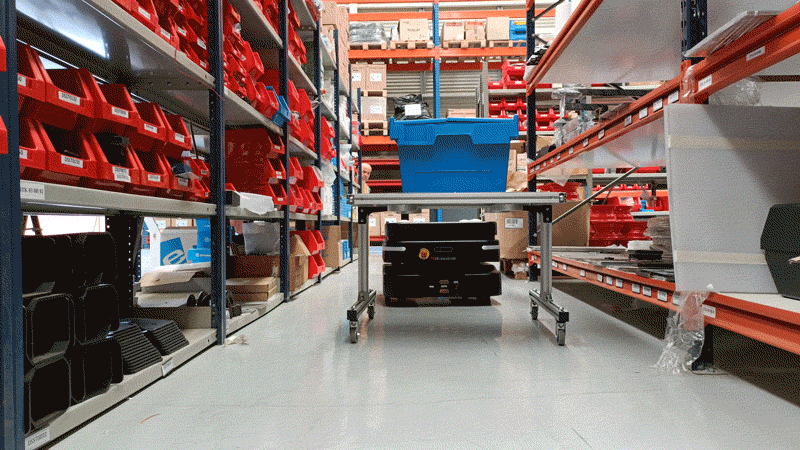One of the areas that has changed the most within the logistics industry is stock control. Automating stock control minimizes the risk of human error and avoids slow operating times. Let’s stay on the topic of Robotics for inventory and stock control: Next step for warehouses.
The implementation of stock control robots in warehouses is not only a trend but a response to the need to adapt to the growing demand of modern commerce
Among the different systems available for automated stock management, we find mobile robotics to perform tasks such as stock review, product replenishment, classification, monitoring and others that we detail below.
This is how stock control robots work and these are some of the main applications of these robots for automated stock management.
The evolution of inventory control in warehouses
Inventory verification and counting tasks were traditionally performed manually, but this manual method is both time-consuming and susceptible to errors or inefficiencies.
The rise of e-commerce, with its demands for speed and accuracy in deliveries, caused companies to look for more agile and technological solutions. This is where inventory robots come into play, allowing the stock control process to be carried out continuously and accurately.
What are inventory control robots?
Warehouse stock control robots are capable of moving through the warehouse autonomously or semi-autonomously, scanning products and detecting inconsistencies in the stock. By integrating specific technology such as sensors, cameras or recognition software, inventory robots can track stock in real time and make decisions accordingly.
- Sensors and cameras: Robots are equipped with high-resolution cameras and sensors to scan barcodes, RFID tags or even to use machine vision to identify and locate products with great precision.
- Autonomous mobility: One of the advantages of mobile robots for stock control is that they can move through warehouses using predefined maps or autonomous navigation algorithms to cover large areas efficiently.
- Connectivity with management systems: Stock management robots are connected to the company’s inventory management systems (WMS) or cloud software platforms. This connectivity allows data to be sent and received in real time, which optimizes stock updating and helps to quickly identify discrepancies.
- Artificial intelligence (AI) and Machine Learning: Some robots use AI to learn patterns in data and improve their performance over time. These robots not only detect inventory, but also predict demands and optimize replenishment strategies.
Robot tasks in stock management
- Cycle inventory and physical counting
One of the most common uses of inventory robots is performing cyclical inventories. Warehouses that use robots can schedule automated inventories on a daily or weekly basis. Robots scan and count products as they move through the warehouse, without needing to close operations to take complete physical inventories.
Furthermore, instead of counting all stock at once, these robots allow for continuous stock control, which helps detect any errors in time, avoiding future problems. - Product identification and tracking
Stock tracking robots are essential to ensure that products are in their correct place within the warehouse. They can scan products throughout the day and check if they are located on designated shelves. If location errors are detected, the robots notify workers to take corrective action.
This automated tracking process is particularly useful in large warehouses, where a mistake in a product’s location can lead to shipping delays or lost sales. - Inventory restocking / replenishment
One of the most in-demand applications is the use of robots for automated stock replenishment. When a product’s stock level drops to a predetermined limit, robots can notify management systems or even automate replenishment orders directly, ensuring that important products are never missing. This optimizes logistics and prevents stock outages. - Verification of product expiration
In industries where products have a limited lifetime (food, pharmaceuticals or cosmetics) automated inventory robots can check the expiration date of products and ensure that the oldest ones are used first. This minimizes losses due to expiration and optimizes inventory use. - Product damage detection
Robots equipped with advanced cameras can detect if a product has been damaged during handling or storage due to, for example, a knock. These robots identify defective products and alert warehouse teams for removal or replacement, improving quality control within the warehouse.
Benefits of robots in inventory control
The fast adoption of robotics for the automation of stock control is due to the multiple advantages it provides, especially in terms of operational efficiency:
- Greater accuracy: Constant inventory tracking significantly reduces human error and provides more precise stock control.
- Time savings: robotic stock control reduces the time workers spent on tedious manual counting tasks, allowing them to focus on higher-value activities.
- Operational efficiency: Due to their ability to work in uninterrupted shifts, warehouse inventory robots can manage large volumes of stock quickly and efficiently.
- Real-time data: The connection between robots and inventory management systems provides a comprehensive real-time data update on the amount of stock available and its exact location in the warehouse.
- Reduction of operating costs: the use of robots for inventory management reduces manual labor costs and the costs associated with inventory errors.
Future of automation of stock control in warehouses
The combination of robotics with emerging technologies such as the Internet of Things (IoT) or Artificial Intelligence continues to open possibilities for warehouse automation, allowing greater integration and coordination between the different phases of the supply chain.
Inventory control robots represent a major advance in the way warehouses manage their stock. By automating tedious and repetitive tasks such as product counting, location verification, or replenishment management, companies can improve operational efficiency, reduce costs, and minimize errors.
The use of robotics for stock control is increasingly integrated into logistics and its adoption is becoming a goal for companies seeking to remain competitive in the market. If you have any questions about Robotics for inventory and stock control: The next step for warehouses, don’t hesitate to ask our team.
Interested in transforming your warehouse operations with robotics? Contact us, our team is happy to help.
FAQs about stock robots
Mobile robots in inventory control has several benefits, including a greater accuracy, important time savings and the improvement of operational efficency.
Stock robots are those capable of automating related inventory control tasks in warehouses or logistics environmentsin an autonomous or semi-autonomous way. They must integrate specific technology such as sensors, cameras or recognition software to track stock in real time and make decisions accordingly.
Stock robots can perform inventory tasks such as verification of product expiration, inventory restocking, product identification or tracking.




